CURRICULUM VITAE
Born: 1958
Position: Research Scientist (contact: lubomir.adamec@ibot.cas.cz)
Office address: Institute of Botany of the Academy of Sciences of the Czech Republic, Section of Plant Ecology, Dukelská 135, CZ-379 82 Třeboň, Czech Republic
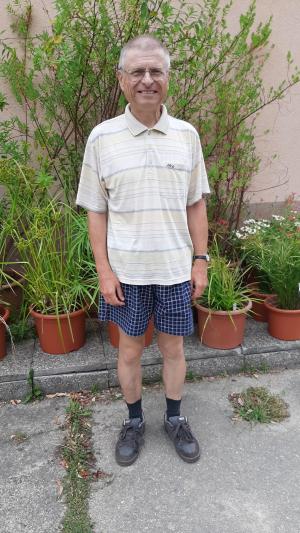
Academic degrees:
1982 M.Sc. Plant Physiology, Charles Univ., Prague, Czechosl.
1982 RNDr. Plant Physiology, Charles Univ., Prague, Czechosl.
1988 PhD. Plant Physiology, Czechoslovak Academy of Sciences
Positions held:
1982-1986: Postgraduate Studentship, Institute of Experimental Botany, Prague
1986-1988: Research Assistent, Institute of Botany, Třeboň, CR
1988-present: Research Scientist, Institute of Botany, Třeboň, CR
Professional Societies:
Czech Botanical Society, Czech Soc. Exper. Biol. Plant (Prague)
Research:
Plant membrane permeability for ions and water relation in plant cells.
Cellular and organ electrophysiology of intact higher plants.
Photoperiodic flower induction in Chenopodium rubrum.
Ecology and physiology of photosynthesis of aquatic plants (alkalization of ambient media, CO2/HCO3- use).
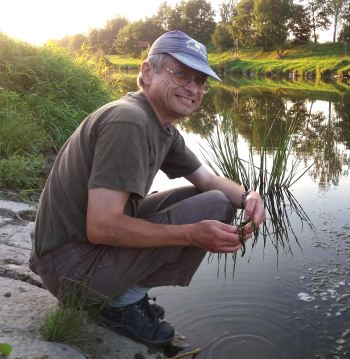
Correlation between photosynthesis and mineral ion uptake by leaves in aquatic plants.
Photosynthesis of aquatic carnivorous plants.
Ecophysiology of Aldrovanda vesiculosa L.
Ecophysiology of turions of aquatic carnivorous plants.
Mineral nutrition and ecophysiology in carnivorous plants.
Ecophysiology of Sphagnum mosses.

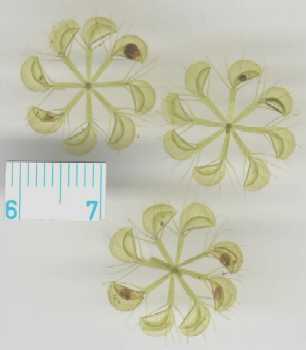 |
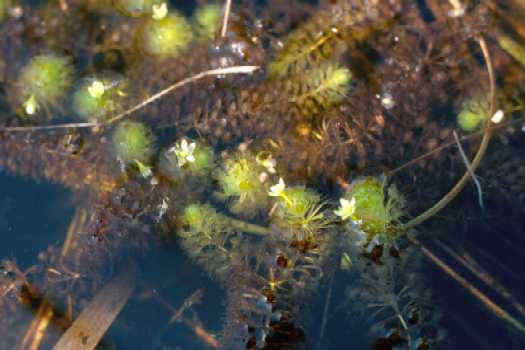 |
|
Leaf whorls of an aquatic carnivorous plant Aldrovanda vesiculosa with captured prey (see www.bestcarnivorousplants.com/aldrovanda/).
|
Aldrovanda vesiculosa flowering at an artificial site at Karstejn, S Bohemia, Czech Republic, August 2001.
|
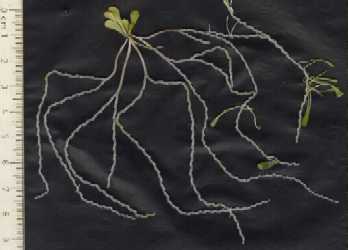 |
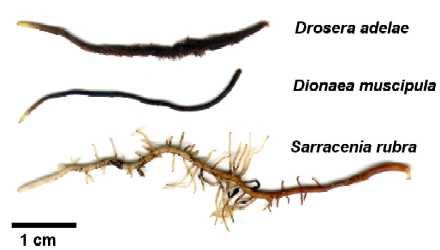 |
|
Genlisea violacea (Lentibulariaceae) traps were used for ecophysiological study.
|
Roots of carnivorous plants used for ecophysiological research.
|
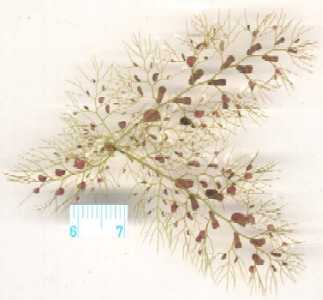 |
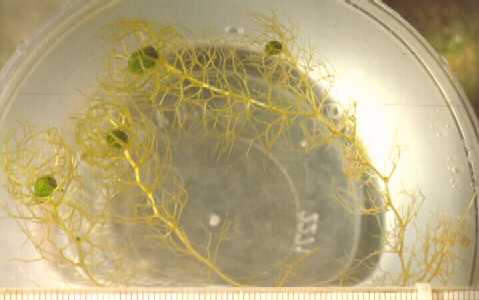 |
|
Utricularia vulgaris traps – model material for studying enzymatic activities and pH in the fluid inside the traps.
|
Turions of Utricularia bremii were used for respiration study.
|
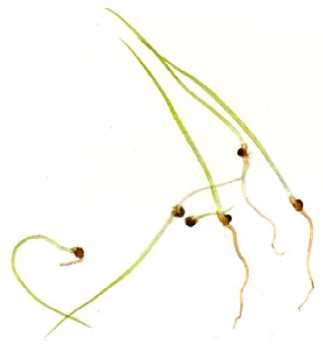 |
 |
|
Young, germinating sporophytes of an aquatic fern Isoetes lacustris from outdoor culture.
|
Potamogeton praelongus propagated in rescue culture for re-introduction.
|
SELECTED PUBLICATIONS (publications labelled in red colour are on-line):
Adamec L., 1984. The effect of plasmolysis and deplasmolysis on the permeability of plant membranes. Biol. Plant. 26: 128-131.
Adamec L., 1988. Použití elektrofyziologických charakteristik při studiu vývojových procesů u rostlin. [The use of electrophysiological parameters i
Adamec L., 1989. The comparison between membrane and transorgan electric potentials in Chenopodium rubrum: The methods. Biol. Plant. 31: 327-335.
Adamec L., Krekule J., 1989. Changes in membrane potential in Chenopodium rubrum during the course of photoperiodic flower induction. Biol. Plant. 31: 336-343.
Adamec L., Krekule J., 1989. Changes in transorgan electric potential in Chenopodium rubrum during the course of photoperiodic flower induction. Biol. Plant. 31: 344-353.
Adamec L., Macháčková I., Krekule J., Nováková M., 1989. Electric current inhibits flowering in the short-day plant
Macháčková I., Adamec L., Pospíš
Adamec L., Ondok J. P., 1992. Water alkalization due to photosynthesis of aquatic plants: the dependence on total alkalinity. Aquat. Bot. 43: 93-98.
Adamec L., Dušáková K., Jonáčková M., 1992.Growth effects of mineral nutrients applied to the substrate or onto the leaves in four carnivorous plant species. Carniv. Plant Newslett. (Fullerton) 20/21: 18-24. (pdf version)
Adamec L., 1993. Rapid inhibition of HCO3- use by high concentration of free CO2 in Elodea canadensis. Aquat. Bot. 45: 311-324.
Adamec L., Husák Š., Janauer G. A., Oťaheľová H., 1993. Phytosociological and ecophysiological study of macrophytes in backwaters in the Danube river inundation area near Palkovičovo (Slovakia). Ekológia (Bratislava) 12: 69-79.
Adamec L., 1995. Photosynthetic inorganic carbon use by aquatic carnivorous plants. Carniv. Plant. Newslett. (Fullerton) 24: 50-53. (pdf version)
Adamec L., 1995. Ecological requirements and the European distribution of the aquatic carnivorous plant Aldrovanda vesiculosa L. Folia Geobot. Phytotax. (Prague) 30: 53-61.
Adamec L., 1995. Ecological requirements of Aldrovanda vesiculosa L. Testing of its new potential sites in the Czech Republic. Acta Bot. Gall. 142: 673-680.
Adamec L., 1995. Ecophysiological study of the aquatic carnivorous plant Aldrovanda vesiculosa L. Acta Bot. Gall. 142: 681-684.
Adamec L., 1995. Photosynthetic inorganic carbon use by aquatic carnivorous plants. Carniv. Plant. Newslett. (Fullerton) 24: 50-53.
Adamec L., 1995. Oxygen budget in the traps of Utricularia australis. Carniv. Plant. Newslett. (Fullerton) 24: 42-45.
Adamec L., 1995. Oxygen budget in the traps of Utricularia australis. Carniv. Plant. Newslett. (Fullerton) 24: 42-45. (pdf version)
Adamec L., 1996. The growth of carnivorous plants on an acidified fen soil. Carniv. Plant. Newslett. (Fullerton) 25: 7-10. (pdf version)
Adamec L., 1996. The growth of carnivorous plants on an acidified fen soil. Carniv. Plant. Newslett. (Fullerton) 25: 7-10.
Kaminski R., Adamec L., Breckpot C., 1996. Report on recent sites of Aldrovanda vesiculosa (Droseraceae) in Poland. Fragm. Flor. Geobot. (Kraków) 41: 291-294.
Adamec L., 1997. Relations between K+ uptake and photosynthetic uptake of inorganic carbon by aquatic plants. Biol. Plant. 39: 599-606. (pdf version)
Adamec L., 1997. Mineral nutrition of carnivorous plants: A review. Bot. Rev. 63: 273-299.
Adamec L., 1997. How to grow Aldrovanda vesiculosa outdoors. Carniv. Plant. Newslett. (Fullerton) 26: 85-88.
Adamec L., Tichý M., 1997. Flowering of Aldrovanda vesiculosa in outdoor culture in the Czech Republic and isozyme variability of its European populations. Carniv. Plant. Newslett. (Fullerton) 26: 99-103.
Adamec L., 1997. Photosynthetic characteristics of the aquatic carnivorous plant Aldrovanda vesiculosa. Aquat. Bot. 59: 297-306.
Adamec L., 1997. Will the rare aquatic carnivorous plant Aldrovanda vesiculosa survive in Europe? Aquaphyte (Gainesville) 17: 4-5.
Adamec L., 1999. Further notes on flowering and seed set of Aldrovanda vesiculosa. Flytrap News (Sydney, NSW) 12(4): 9-12.
Adamec L., 1999. Seasonal growth dynamics and overwintering of the aquatic carnivorous plant Aldrovanda vesiculosa at experimental field sites. Folia Geobot. 34: 287-297. (pdf version)
Adamec L., Lev J., 1999. The introduction of the aquatic carnivorous plant Aldrovanda vesiculosa to new potential sites in the Czech Republic: A five-year investigation. Folia Geobot. 34: 299-305. (pdf version)
Adamec L., 1999. Turion overwintering of aquatic carnivorous plants. Carniv. Plant. Newslett. (Fullerton) 28: 19-24. (pdf version)
Adamec L., 1999. The biology and cultivation of red Australian Aldrovanda vesiculosa. Carniv. Plant. Newslett. (Fullerton) 28: 128-132. (pdf version)
Adamec L., 2000. Rootless aquatic plant Aldrovanda vesiculosa: physiological polarity, mineral nutrition, and importance of carnivory. Biol. Plant. 43: 113-119. (pdf version)
Raspopov I. M., Adamec L., Husák Š., 2000. Long-term aspects of aquatic macrophytes in two bays of Lake Ladoga of different nutrient status. In: Peltonen A., Grönlund E., Viljanen M. (eds.), Proceedings of the Third International Lake Ladoga Symposium 1999. Publ. of Karelian Inst. No. 129, University of Joensuu, Finland, pp. 148-151.
Adamec A., Pásek K., 2000. Medium optimization for growing Aldrovanda vesiculosa in vitro. Carniv. Plant. Newslett. (Fullerton) 29: 122-124. (pdf version)
Adamec L., 2000. Summary of CO2 enrichment for aquatic CPs. Flytrap News (Sydney, N.S.W.) 13 (4): 14-15.
Adamec A., Pásek K., 2000. Medium optimization for growing Aldrovanda vesiculosa in vitro. Carniv. Plant. Newslett. (Fullerton) 29: 122-124.
Masojídek J., Pechar L., Koblížek M., Adamec L., Komenda J., 2001. Affinity of surface phytoplankton populations to high irradiance in hypertrophic fish ponds: implications of the competition between chlorococcal algae and cyanobacteria. Nova Hedw., Beih. 123: 255-273.
M. Oliur Rahman, Lubomír Adamec, Katsuhiko Kondo, 2001. Chromosome numbers of Utricularia bremii and Utricularia dimorphantha (Lentibulariaceae). Chromosome Science 5: 105–108. (pdf version)
Adamec L., Lev J., 2002. Ecological differences between Utricularia ochroleuca and U. intermedia habitats. Carniv. Plant. Newslett. (Fullerton) 31: 14-18.
Adamec L., 2002. Leaf absorption of mineral nutrients in carnivorous plants stimulates root nutrient uptake. New Phytol. 155: 89-100. (pdf version)
Adamec L., Husák Š., 2002. Control of Eurasian Watermilfoil in NNR Břehyňský fishpond near Doksy, Czech Republic. J. Aquat. Plant Manage. 40: 45-46.
Raspopov I. M., Adamec L., Husák Š., 2002. Influence of aquatic macrophytes on the littoral zone habitats of the Lake Ladoga, NW Russia. Preslia 74: 315-321. (pdf version)
Adamec L., Kondo K., 2002. Optimization of medium for growing the aquatic carnivorous plant Aldrovanda vesiculosa in vitro. Plant Biotechnol. 19: 283-286.
Adamec L., Lev J., 2002. Ecological differences between Utricularia ochroleuca and U. intermedia habitats. Carniv. Plant. Newslett. (Fullerton) 31: 14-18. (pdf version)
-- Adamec L., 2003. . Zero water flows in the carnivorous genus Genlisea. Carniv. Plant. Newslett. (Fullerton) 32: 46-48. (pdf version)
Maldonado San Martín A. P., Adamec L., Suda J., Mes T. H. M., Štorchová H., 2003. Genetic variation within the endangered species Aldrovanda vesiculosa (Droseraceae) as revealed by RAPD analysis. Aquat.Bot. 75: 159-172. (pdf version)
Sirová D., Adamec L., Vrba J., 2003. Enzymatic activities in traps of four aquatic species of the carnivorous genus Utricularia. New Phytol. 159: 669-675. (pdf version)
Adamec L., 2003. Ecophysiological comparison of green Polish and red Australian plants of Aldrovanda vesiculosa. Carniflora Aust. 1: 4-17.
Adamec L., 2003. Ecophysiological characterization of dormancy states in turions of the aquatic carnivorous plant Aldrovanda vesiculosa. Biol. Plant. 47: 395-402. (pdf version)
Adamec L., 2005. Ecophysiological characterization of carnivorous plant roots: oxygen fluxes, respiration, and water exudation. Biol. Plant. 49: 247-255. (pdf version)
Adamec L., 2005. Ten Years after the Introduction of Aldrovanda vesiculosa to the Czech Republic. Acta Botanica Gallica 152: 239-245. (doc version)
Adamec L., Kovářová M., 2006. Field growth characteristics of two aquatic carnivorous plants, Aldrovanda vesiculosa and Utricularia australis. Folia Geobot. 41: 395-406. (pdf version)
Adamec L., 2006. Respiration and photosynthesis of bladders and leaves of aquatic Utricularia species. Plant Biol. 8: 765-769. (pdf version)
Płachno B. J., Adamec L., Lichtscheidl I. K., Peroutka M., Adlassnig W., Vrba J., 2006. Fluorescence labelling of phosphatase activity in digestive glands of carnivorous plants. Plant Biol. 8: 813-820. (pdf version)
Adamec L., Gastinel L., Schlauer J., 2006. Plumbagin content in Aldrovanda vesiculosa shoots. Carniv. Plant Newslett. 35: 52-55. (pdf version)
Adamec L., Kohout P., Beneš K., 2006. . Root anatomy of three carnivorous plant species. Carniv. Plant Newslett. (Fullerton) 35: 19-22. (pdf version)
Adamec L., 2007. Investment in carnivory in Utricularia stygia and U. intermedia with dimorphic shoots. Preslia 79: 127-139. (pdf version)
Płachno B. J., Adamec L., 2007. Differentiation of Utricularia ochroleuca and U. stygia populations in Třeboň basin, on the basis of quadrifid glands. Carniv. Plant Newslett. (Fullerton) 36: 87-95. (pdf version)
Adamec L., 2007. Oxygen concentrations inside the traps of the carnivorous plants Utricularia and Genlisea (Lentibulariaceae). Ann. Bot. 100: 849-856. (pdf version)
Adamec L., 2007. Micronutrient content does not reflect the status of health in the aquatic carnivorous plant Aldrovanda vesiculosa. Biologia 62: 711-714. (pdf version)
Adamec L., 2008. Soil fertilization enhances growth of the carnivorous plant Genlisea violacea. Biologia 63/2: 201—203. (pdf version)
Adamec L., 2008. The influence of prey capture on photosynthetic rate in two aquatic carnivorous plant species. Aquatic Botany 89: 66–70. (pdf version)
Adamec L., 2008. Respiration of turions and winter apices in aquatic carnivorous plants. Biologia 63/4: 515—520. (pdf version)
Adamec L., 2008. SURVIVAL OF DRIED TURIONS OF AQUATIC CARNIVOROUS PLANTS. Carniv. Plant. Newslett. (Fullerton) 37: 52-56. (pdf version)
Adamec L., 2008. Mineral nutrient relations in the aquatic carnivorous plant Utricularia australis and its investment in carnivory. Fund. Appl. Limnol. 171/3: 175–183. (pdf version)
Dagmara Sirová, Jakub Borovec, Barbora Černá, Eliška Rejmánková, Lubomír Adamec, Jaroslav Vrba, 2009. Microbial community development in the traps of aquatic Utricularia species. Aquat. Bot. 90: 129–136. (pdf version)
Lubomír Adamec, 2009. Photosynthetic CO2 affinity of the aquatic carnivorous plant Utricularia australis(Lentibulariaceae) and its investment in carnivory. Ecol Res 24: 327–333. (pdf version)
Tomáš Hájek, Lubomír Adamec, 2009. Mineral nutrient economy in competing species of Sphagnum mosses. Ecol Res 24: 291–302. (pdf version)
Płachno B. J., Adamec L., Huet H., 2009. Mineral nutrient uptake from prey and glandular phosphatase activity as a dual test of carnivory in semi-desert plants with glandular leaves suspected of carnivory. Ann. Bot. 104: 649–654. (pdf version)
Adamec L., 2009. ECOPHYSIOLOGICAL INVESTIGATION ON DROSOPHYLLUM LUSITANICUM: WHY DOESN’T THE PLANT DRY OUT? Carniv. Plant Newslett. 38: 71-74. (pdf version)
Adamec L., Pásek K., 2009. Photosynthetic CO2 affinity of aquatic carnivorous plants growing under nearly-natural conditions and in vitro. Carniv. Plant Newslett. (Fullerton) 38: 107-113. (pdf version)
Tomáš Hájek, Lubomír Adamec, 2010. Photosynthesis and dark respiration of leaves of terrestrial carnivorous plants. Biologia 65/1: 69—74. (pdf version)
Hosam O.M. Elansary, Lubomír Adamec, Helena Štorchová, 2010. Uniformity of organellar DNA in Aldrovanda vesiculosa, an endangered aquatic carnivorous species, distributed across four continents. Aquat. Bot. 92: 214–220. (pdf version)
Adamec L., 2010. Dark respiration of leaves and traps of terrestrial carnivorous plants: are there greater energetic costs in traps? Cent. Eur. J. Biol. 5(1): 121–124. (pdf version)
Dagmara Sirová, Jakub Borovec, Hana Šantrůčková, Jiří Šantrůček, Jaroslav Vrba, Lubomír Adamec, 2010. Utricularia carnivory revisited: plants supply photosynthetic carbon to traps. Journal of Experimental Botany 61/1: 99–103. (pdf version)
Lubomír Adamec, Dagmara Sirová, Jaroslav Vrba, Eliška Rejmánková, 2010. Enzyme production in the traps of aquatic Utricularia species. Biologia 65/2: 273—278. (pdf version)
Lubomír Adamec , Dagmara Sirová and Jaroslav Vrba, 2010. Contrasting growth effects of prey capture in two aquatic carnivorous plant species. Fundam. Appl. Limnol., Arch. Hydrobiol. Vol. 176/2, 153–160 (pdf version)
Lubomír Adamec, 2010. Tissue mineral nutrient content in turions of aquatic plants: does it represent a storage function? Fundam. Appl. Limnol., Arch. Hydrobiol. Vol. 176/2, 145–151 (pdf version)
Lubomír Adamec, 2010. Field Growth Analysis of Utricularia stygia and U. intermedia Two Aquatic Carnivorous Plants with Dimorphic Shoots. Phyton 49: 241—251. (pdf version)
Lubomír Adamec, 2010. Mineral cost of carnivory in aquatic carnivorous plants Flora 205: 618-621. (pdf version)
Adamec L., 2010.Ecophysiological look at organ respiration in carnivorous plants: A review. In: Osterhoudt G., Barhydt J. (eds.), Cell Respiration and Cell Survival: Processes, Types and Effects. Nova Science Publishers, Inc., New York, pp. 225-235. (pdf version)
Lubomír Adamec, 2011. The comparison of mechanically stimulated and spontaneous firings in traps of aquatic carnivorous Utricularia species, Aquatic Botany 94 (2011) 44–49. (pdf version)
Lubomír Adamec, 2011. Adamec L., 2011. Ecophysiological look at plant carnivory: Why are plants carnivorous? In: Seckbach J., Dubinski Z. (eds.), All Flesh is Grass. Plant-Animal Interrelationships. Cellular Origin, Life in Extreme Habitats and Astrobiology Vol. 16. Springer Science + Business Media B. V., Dordrecht - Heidelberg - London - New York, pp. 455-489. (pdf version)
Lubomír Adamec, 2011. By which mechanism does prey capture enhance plant growth in aquatic carnivorous plants: Stimulation of shoot apex?, Fundam. Appl. Limnol. Vol. 178/2, 171–176. (pdf version)
Adamec L., Vrba J., Sirová D., 2011. Fluorescence tagging of phosphatase and chitinase activity on different structures of Utricularia traps. Carniv. Plant Newslett. 40: 68-73. (pdf version)
Adamec L., 2011. Shoot branching of the aquatic carnivorous plant Utricularia australis as the key process of plant growth. Phyton 51: 133-148. (pdf version)
Sirová D., Borovec J., Picek T., Adamec L., Nedbalová L., Vrba J., 2011. Ecological implications of organic carbon dynamics in the traps of aquatic carnivorous Utricularia plants. Funct. Plant Biol. 38: 583-593. (pdf version)
Adamec L., 2011. The smallest but fastest: Ecophysiological characteristics of traps of aquatic carnivorous Utricularia. Plant Signal. Behav. 6: 640-646. (pdf version)
Prausová R., Janová J., Adamec L., 2011.Rescue of the critically endangered long-stalked pondweed (Potamogeton praelongus) in the Czech Republic. Acta Biol. Sloven. 54: 43-54. (pdf version)
Adamec L., 2011.Functional characteristics of traps of aquatic carnivorous Utricularia species. Aquat. Bot. 95: 226-233. (pdf version)
Adamec L., 2011.Dark respiration and photosynthesis of dormant and sprouting turions of aquatic plants. Fundam. Appl. Limnol. 179: 151-158.(pdf version)
Ellison A. M., Adamec L., 2011.Ecophysiological traits of terrestrial and aquatic carnivorous plants: are the costs and benefits the same? Oikos 120: 1721-1731. (pdf version)
Król E., Płachno B. J., Adamec L., Stolarz M., Dziubińska H., Trębacz K., 2012.Quite a few reasons for calling carnivores ‘the most wonderful plants in the world’. Ann. Bot. 109: 47-64. (pdf version)
Płachno B. J., Łukaszek M., Wołowski K., Adamec L., Stolarczyk P., 2012.Aging of Utricularia traps and variability of microorganisms associated with that microhabitat. Aquat. Bot. 97: 44-48. (pdf version)
Guitton Y., Legendre L., Adamec L., 2012.Mineral nutrition in hydroponically-grown Pinguicula. Carniv. Plant Newslett. (Pinole) 41: 8-15. (pdf version)
Adamec L., 2012. News in ecophysiological research on aquatic Utricularia traps. Carniv. Plant Newslett. (Pinole) 41: 92-104. (pdf version)
Macek P., Klimeš L., Adamec L., Doležal J., Chlumská Z., de Bello F., Dvorský M., Řeháková K., 2012.Plant nutrient content does not simply increase with elevation under the extreme environmental conditions of Ladakh, NW Himalaya. Arctic Antarctic Alpine Res. 44: 62–66. (pdf version)
Adamec L., 2012. Why do aquatic carnivorous plants prefer growing in dystrophic waters? Acta Biol. Sloven. 55: 3-8. (pdf version)
Borovec J., Sirová D., Adamec L., 2012.Light as a factor affecting the concentration of simple organics in the traps of aquatic carnivorous Utricularia species. Fundam. Appl. Limnol. 181: 159-166. (pdf version)
Adamec L., 2012.Firing and resetting characteristics of carnivorous Utricularia reflexa traps: Physiological or only physical regulation of trap triggering? Phyton 52: 281-290. (pdf version)
Adamec L., 2013.Foliar mineral nutrient uptake in carnivorous plants: what do we know and what should we know? Front. Plant Sci. 4: 10. (pdf version)
Kitner M., Prausová R., Adamec L., 2013.Present status of genetic diversity of Potamogeton praelongus populations in the Czech Republic. Phyton 53: 73-86. (pdf version)
Adamec L., Kučerová A., 2013. Overwintering temperatures affect freezing temperatures of turions of aquatic plants. Flora 208: 497-501. (pdf version)
Adamec L., 2013. A comparison of photosynthetic and respiration rates in six aquatic carnivorous Utricularia species differing in morphology. Aquat. Bot. 111: 89–94. (pdf version)
Lamont E. E., Sivertsen R., Doyle C., Adamec L., 2013. Extant populations of Aldrovanda vesiculosa (Droseraceae) in the New World. J. Torrey Bot. Soc. 140: 517–522. (pdf version)
Pavlovič A., Krausko M., Libiaková M., Adamec L., 2014. Feeding on prey increases photosynthetic efficiency in the carnivorous sundew Drosera capensis. Ann. Bot. 113: 69-78. (pdf version)
Beretta M., Rodondi G., Adamec L., Andreis C., 2014. Pollen morphology of European bladderworts (Utricularia L., Lentibulariaceae). Rev. Palaeobot. Palynol. 205: 22-30. (pdf version)
Adamec L., 2014. Different reutilization of mineral nutrients in senescent leaves of aquatic and terrestrial carnivorous Utricularia species. Aquat. Bot. 119: 1-6. (pdf version)
Sirová D., Šantrůček J., Adamec L., Bárta J., Borovec J., Pech J., Owens S. M., Šantrůčková H., Schäufele R., Štorchová H., Vrba J., 2014. Dinitrogen fixation associated with shoots of aquatic carnivorous plants: is it ecologically important? Ann. Bot. 114: 125-133. (pdf version)
Veleba A., Bureš P., Adamec L., Šmarda P, Lipnerová I., Horová L., 2014. Genome size and genomic GC content evolution in the miniature genome-sized family Lentibulariaceae. New Phytol. 203: 22-28. (pdf version)
Płachno B. J., Adamec L., Kozieradzka-Kiszkurno M., Świątek P., Kamińska I. 2014. Cytochemical and ultrastructural aspects of aquatic carnivorous plant turions. Protoplasma 251: 1449-1454. (pdf version)
Płachno B. J., Adamec L., Kamińska I., 2014 Relationship between trap anatomy and function in Australian carnivorous bladderworts (Utricularia) of the subgenus Polypompholyx. Aquat. Bot. 120: 290-296. (pdf version)
Appenroth K. J., Adamec L., 2015 Specific turion yields of different clones of Spirodela polyrhiza depend on external phosphate thresholds. Plant Biol. 17 (Suppl 1): 125-129. (pdf version)
Bárta J., Stone J. D., Pech J., Sirová D., Adamec L., Campbell M. A., Štorchová H., 2015. The transcriptome of Utricularia vulgaris, a rootless plant with minimalist genome, reveals extreme alternative splicing and only moderate sequence similarity with Utricularia gibba. BMC Plant Biol. 15: 78. (pdf version)
Adamec L., 2015. Regulation of the investment in carnivory in three aquatic Utricularia species: CO2 or prey availability? Phyton 55: 131-148. (pdf version)
Cross A. T., Skates L. M., Adamec L., Hammond C. M., Sheridan P. M., Dixon K. W., 2015. Population ecology of the endangered aquatic carnivorous macrophyte Aldrovanda vesiculosa at a naturalised site in North America. Freshwater Biol. 60: 1772-1783. (pdf version)
Adamec L., Fleischmann A., Pásek K., 2015. Biology of the trapless rheophytic Utricularia neottioides : Is it possible to grow this specialized species in cultivation? Carniv. Plant Newslett. (Fullerton) 44: 104-114. (pdf version)
Adamec L., 2015. Soil pH values at sites of terrestrial carnivorous plants in south-west Europe. Carniv. Plant Newslett. (Fullerton) 44: 185-188. (pdf version)
Adamec L., 2015. Is long-term survival of dried turions of aquatic carnivorous plants possible? Carniv. Plant Newslett. (Fullerton) 44: 189-194. (pdf version)
Pavlovič A., Krausko M., Adamec L., 2016. A carnivorous sundew plant prefers protein over chitin as a source of nitrogen from its traps. Plant Physiol. Biochem. 104: 11-16. (pdf version)
Cross A. T., Adamec L., Turner S. R., Dixon K. W., Merritt D. J., 2016. Seed reproductive biology of the rare aquatic carnivorous plant Aldrovanda vesiculosa (Droseraceae). Bot. J. Linn. Soc. 180: 515-529. (pdf version)
Adamec L., 2016. Mineral nutrition in aquatic carnivorous plants: effect of carnivory, nutrient reutilization and K+ uptake. Fundam. Appl. Limnol. 188: 41-49. (pdf version)
Adamec L., Poppinga S., 2016. Measurement of the critical negative pressure inside traps of aquatic carnivorous Utricularia species. Aquat. Bot. 133: 10-16. (pdf version)
Masi E., Ciszak M., Colzi I., Adamec L., Mancuso S., 2016. Resting electrical network activity in traps of the aquatic carnivorous plants of the genera Aldrovanda and Utricularia. Sci. Rep. 6: e24989. (pdf version)
Šimura J., Spíchal L., Adamec L., Pěnčík A., Rolčík J., Novák O., Strnad M., 2016. Cytokinin, auxin and physiological polarity in the aquatic carnivorous plants Aldrovanda vesiculosa and Utricularia australis. Ann. Bot. 117: 1037-1044. (pdf version)
Adamec L., 2016. The morphometry of quadrifid digestive glands in traps of three Utricularia species: Does gland size correlate with trap size? Phyton 56: 27-38. (pdf version)
Adamec L., 2016. European aquatic carnivorous Utricularia species – record-holders, but vanishing beauties of our nature. Danube News (Vienna) 18: 12-14. (pdf version)
Maglovski M., Gregorová Z., Rybanský Ľ., Mészáros P., Moravčíková J., Hauptvogel P., Adamec L., Matušíková I., 2017. Nutrition supply affects the activity of pathogenesis-related ß-1,3-glucanases and chitinases in wheat. Plant Growth Regul. 81: 443–453. (pdf version)
Pitsch G., Adamec L., Dirren S., Nitsche F., Šimek K., Sirová D., Posch T., 2017. The green Tetrahymena utriculariae n. sp. (Ciliophora, Oligohymenophorea) with its endosymbiotic algae (Micractinium sp.), living in the feeding traps of a carnivorous aquatic plant. J. Eukaryot. Microbiol. 64: 322–335. (pdf version)
Šimek K., Pitsch G., Salcher M. M., Sirová D., Shabarova T., Adamec L., Posch T., 2017. Ecological traits of a zoochlorellae-bearing Tetrahymena sp. (Ciliophora) living in traps of the carnivorous aquatic plant Utricularia reflexa. J. Eukaryot. Microbiol. 64: 336-348. (pdf version)
Płachno B. J., Kamińska I., Adamec L., Świątek P., 2017. Vascular tissue in traps of Australian carnivorous bladderworts (Utricularia) of the subgenus Polypompholyx. Aquat. Bot. 142: 25–31 (pdf version)
Płachno B. J., Stpiczyńska M., Krajewski Ł., Świątek P., Adamec L., Miranda V. F. O., 2017. Flower palate structure of the aquatic bladderworts Utricularia bremii Heer and U. minor L. from section Utricularia (Lentibulariaceae). Protoplasma 254: 2007–2015. (pdf version)
Hoshi Y., Azumatani M., Suyama C., Adamec L., 2017. Determination of ploidy level and nuclear DNA content in the Droseraceae by flow cytometry. Cytologia 82: 321-327. (pdf version)
Adamec L., 2017. Quantification of growth benefit of carnivorous plants from prey. Carniv. Plant Newslett. (Fullerton) 46: 1-7. (pdf version)
Rodrigues F. G., Marulanda N. F., Silva S. R., Płachno B. J., Adamec L., Miranda V. F. O., 2017. Phylogeny of the ‘orchid-like’ bladderworts (gen.Utricularia sect. Orchidioides and Iperua: Lentibulariaceae) with remarks on the stolon–tuber system. Ann. Bot.120: 709–723. (pdf version)
Silva S. R., Gibson R., Adamec L., Domínguez Y., Miranda V. F. O., 2018. Molecular phylogeny of bladderworts: A wide approach of Utricularia (Lentibulariaceae) species relationships based on six plastidial and nuclear DNA sequences. Mol. Phylogen. Evol. 118: 244–264. (pdf version)
Ellison A. M., Adamec L. (eds.), 2018. Carnivorous Plants: Physiology, Ecology, and Evolution. Oxford University Press, Oxford, U.K., 510 p. (Cover) (Table of contents)
Adamec L., Pavlovič A., 2018. Mineral nutrition of terrestrial carnivorous plants. In: Carnivorous Plants: Physiology, Ecology, and Evolution. Ellison A. M. and Adamec L. (eds.). Oxford University Press, Oxford, U.K., pp. 221-231.
Adamec L., 2018. Ecophysiology of aquatic carnivorous plants. In: Carnivorous Plants: Physiology, Ecology, and Evolution. Ellison A. M. and Adamec L. (eds.). Oxford University Press, Oxford, U.K., pp. 256-269.
Ellison A. M., Adamec L., 2018. Introduction: what is a carnivorous plant? In: Carnivorous Plants: Physiology, Ecology, and Evolution. Ellison A. M. and Adamec L. (eds.). Oxford University Press, Oxford, U.K., pp. 3-6.
Ellison A. M., Adamec L., 2018. The future of research with carnivorous plants. In: Carnivorous Plants: Physiology, Ecology, and Evolution. Ellison A. M. and Adamec L. (eds.). Oxford University Press, Oxford, U.K., pp. 408-409.
Westermeier A. S., Sachse R., Poppinga S., Vögele P., Adamec L., Speck T., Bischoff M., 2018. How the carnivorous waterwheel plant (Aldrovanda vesiculosa) snaps. Proc. R. Soc. B-Biol. Sci. 285: e20180012. (pdf version)
Bartosz J. Płachno B. J., Stpiczyńska M., Adamec L., Miranda V. F. O., Świątek P., 2018. Nectar trichome structure of aquatic bladderworts from the section Utricularia (Lentibulariaceae) with observation of flower visitors and pollinators. Protoplasma 255: 1053–1064. (pdf version)
Adamec L., 2018. Germination rate and longevity of seeds of Aldrovanda vesiculosa and Utricularia vulgaris. Carniv. Plant Newslett. 47: 64-69. (pdf version)
Adamec L., 2018. Ecophysiological characteristics of aquatic carnivorous plants: A review. In: Janauer G. A., Gaberščik A., Květ J., Germ M., Exler N. (eds.): Macrophytes of the River Danube Basin. Academia, Prague, pp. 334-360. (pdf version)
Adamec L., 2018. Ecophysiological characteristics of turions of aquatic plants: A review. Aquat. Bot. 148: 64–77. (pdf version)
Adamec L., 2018. Biological flora of Central Europe: Aldrovanda vesiculosa L. Perspect. Plant Ecol. Evol. Syst. 35: 8–21. (pdf version)
Kolodin P., Cempírková H., Bureš P., Horová L., Veleba A., Francová J., Adamec L., Zedek F., 2018. Holocentric chromosomes may be an apomorphy of Droseraceae. Plant Syst. Evol. 304:1289–1296 (pdf version)
Sirová D., Bárta J., Šimek K., Posch T., Pech J., Stone J., Borovec J., Adamec L., Vrba J., 2018. Hunters or farmers? Microbiome characteristics help elucidate the diet composition in an aquatic carnivorous plant. Microbiome 6: 225. (pdf version)
Płachno B. J., Świątek P., Adamec L., Carvalho S., Miranda V. F. O., 2019. The trap architecture of Utricularia multifida and Utricularia westonii (subg. Polypompholyx). Front. Plant Sci. 10: e336. (pdf version)
Horstmann M., Heier L., Kruppert S., Weiss L. C., Tollrian R., Adamec L., Westermeier A., Speck T., Poppinga S., 2019. Comparative prey spectra analyses on the endangered aquatic carnivorous waterwheel plant (Aldrovanda vesiculosa, Droseraceae) at several naturalized microsites in the Czech Republic and Germany. Integr. Organism. Biol. 1: oby012. (pdf version)
Schweingruber F. H., Kučerová A., Adamec L., Doležal J., 2020. Anatomic Atlas of Aquatic and Wetland Plant Stems. Springer Nature Switzerland AG, Cham, Switzerland, 487 p. (pdf version)
Adamec L., 2020. Biological flora of Central Europe: Utricularia intermedia Hayne, U. ochroleuca R.W. Hartm., U. stygia Thor and U. bremii Heer ex Kölliker. Perspect. Plant Ecol. Evol. Syst. 44: e125520. (pdf version)
Shukla S. P., Kvíderová J., Adamec L., Elster J., 2020. Ecophysiological features of polar soil unicellular microalgae. J. Phycol. 56: 481–495. (pdf version)
Astuti, G., Petroni, G., Adamec, L., Miranda, V.F.O., Peruzzi, L., 2020. DNA barcoding approach fails to discriminate central European bladderworts (Utricularia, Lentibulariaceae), but provides insights concerning their evolution. Plant Biosystems 154: 326–336. (pdf version)
Adamec L., Kučerová A., Janeček Š., 2020. Mineral nutrients, photosynthetic pigments and storage carbohydrates in turions of 21 aquatic plant species. Aquat. Bot. 165: 103238. (pdf version, Supplement )
Palfalvi G., Hackl T., Terhoeven N., Shibata T. F., Nishiyama T., Ankenbrand M., Becker D., Förster F., Freund M., Iosip A., Kreuzer I., Saul F., Kamida C., Fukushima K., Shuji Shigenobu S., Tamada Y., Adamec L., Hoshi Y., Ueda K., Winkelmann T., Fuchs J., Schubert I., Schwacke R., Al-Rasheid K., Schultz J., Hasebe M., Hedrich R., 2020. Genomes of the Venus flytrap and close relatives unveil the roots of plant carnivory. Curr. Biol. 30: 2312-2320. (pdf version)
Svobodová I., Adamec L., 2020. Preliminary identification of the agent causing the fungal disease of Aldrovanda vesiculosa. Carniv. Plant Newslett. 49: 56-64. (pdf version)
Płachno B. J., Adamec L., Świątek P., Kapusta M., Miranda V. F. O., 2020. Life in the current: Anatomy and morphology of Utricularia neottioides. Int. J. Mol. Sci. 21: e4474. (pdf version)
Krajewski Ł., Adamec L., Saługa M., Bednarek-Ochyra H., Plášek V., 2020. Welcome to the Czech Republic again! Rare northern mosses Calliergon megalophyllum and Drepanocladus sordidus (Amblystegiaceae) in South Bohemia in light of their European distribution and habitat preferences. Phytokeys 154: 111-136. (pdf version)
Sirová D., Kreidlová V., Adamec L., Vrba J., 2020. The ability of Tetrahymena utriculariae (Ciliophora, Oligohymenophorea) to colonize traps of different species of aquatic carnivorous Utricularia. J. Eukaryot. Microbiol. 67: 608-611. (pdf version)
Cross A., Adamec L., 2020. Aldrovanda vesiculosa. The IUCN Red List of Threatened Species 2020: e.T162346A83998419. https://dx.doi.org/10.2305/IUCN.UK.2020-1.RLTS.T162346A83998419.en (pdf version)
Płachno B. J., Strzemski M., Dresler S., Adamec L., Wojas-Krawczyk K., Sowa I., Danielewicz A., Miranda V. F. O., 2021. A chemometry of Aldrovanda vesiculosa L. (Waterwheel, Droseraceae) populations. Molecules 26: e72. (pdf version)
Onelli E., Beretta M., Moscatelli A., Caccianiga M., Pozzi M., Stroppa N., Adamec L., 2021. The aquatic carnivorous plant Aldrovanda vesiculosa (Droseraceae) exhibits altered developmental stages in male gametophyte. Protoplasma 258: 71–85. (pdf version)
Maglovski M., Rybanský Ľ., Bujdoš M., Adamec L., Bardáčová M., Blehová A., Matušíková I., 2021. Nitrogenous nutrition affects uptake of arsenic and defense enzyme responses in wheat. Pol. J. Environ. Stud. 30: 2213-2224. (pdf version)
Doležal J., Kučerová A., Jandová V., Klimeš A., Říha P., Adamec L., Schweingruber F. H., 2021. Anatomical adaptations in aquatic and wetland dicot plants: Disentangling the environmental, morphological and evolutionary signals. Environ. Exp. Bot. 187: e104495. (pdf version)
(supplement pdf version)Jakšová J., Adamec L., Petřík I., Novák O., Šebela M., Pavlovič A., 2021. Contrasting effect of prey capture on jasmonate accumulation in two genera of aquatic carnivorous plants (Aldrovanda, Utricularia). Plant Physiol. Biochem. 166: 459–465. (pdf version)
Adamec L., Matušíková I., Pavlovič A., 2021. Recent ecophysiological, biochemical and evolutional insights into plant carnivory. Ann. Bot. 128: 241–259. (pdf version)
Martínková J., Hájek T., Adamec L., Klimešová J., 2021. Growth, root respiration and photosynthesis of a root-sprouting short-lived herb after severe biomass removal. Flora 284: e151915. (pdf version)
Matos R. G., Silva S. R., Płachno B. J., Adamec L., Michael T. P., Varani A. M., Miranda V. F. O., 2022. The complete mitochondrial genome of carnivorous Genlisea tuberosa (Lentibulariaceae): Structure and evolutionary aspects. Gene 824: e146391.(pdf version)
Prausová R., Holzbauerová H., Špringrová I., Jará N., Šafářová L., Cross A. T., Adamec L., 2022. Seed germination ecology of common bladderwort (Utricularia vulgaris L.). Aquat. Bot. 182: e103545. (pdf version)
Adamec L., Kučerová A., 2022. Morphometry of shoots and flowers of Utricularia minor at a large site in the Czech Republic. Carniv. Plant Newslett. 51: 84-91. (pdf version)
Pavlovič A., Jakšová J., Hrivňacký M., Adamec L., 2022. Alternative or cytochrome? Respiratory pathways in traps of aquatic carnivorous bladderwort Utricularia reflexa. Plant Signal. Behav. 17: e2134967. (pdf version)
Adamec L., 2022. Resorption of N, P, and K from the floating and submerged leaves of the aquatic fern Salvinia natans. Bot. Serb. 46: 253-258. (pdf version)
Martínková J., Klimeš A., Motyka V., Adamec L., Dobrev P. I., Filepová R., Gaudinová A., Lacek J., Marešová I., Klimešová J., 2023. Why is root sprouting not more common among plants? Phytohormonal clues and ecological correlates. Environ. Exp. Bot. 205: e105147.(pdf version)
Martínková J., Motyka V., Bitomský M., Adamec L., Dobrev P. I., Filartiga A., Filepová R., Gaudinová A., Lacek J., Klimešová J., 2023. What determines root?sprouting ability: injury or phytohormones? Am. J. Bot. 110: e16102. (pdf version)
Silva S. R., Miranda V. F. O., Michael T. P., Płachno B. J., Matos R. G., Adamec L., Pond S. L. K., Lucaci A. G., Pinheiro D. G., Varani A. M., 2023. The phylogenomics and evolutionary dynamics of the organellar genomes in carnivorous Utricularia and Genlisea species (Lentibulariaceae). Mol. Phylogen. Evol. 181: e107711. (pdf version)
Adamec L., Plačková L., Doležal K., 2024. Characteristics of turion development in two aquatic carnivorous plants: Hormonal profiles, gas exchange and mineral nutrient content. Plant Direct 8: e558. (pdf version)
Štorchová H., Krüger M., Small I., Adamec L., Nevill P. G., Howell K. A., Dixon K. W., Derbyshire M., Zhong X., Cross A. T., 2024. Global mitochondrial and chloroplast genome diversity in the threatened aquatic carnivorous plant Aldrovanda vesiculosa. Aquat. Bot. 191: e103742. (pdf version)